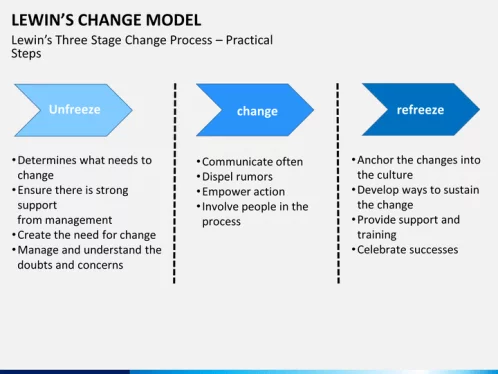
Change can be unsettling, especially when it’s introduced without any formal structure.
Staff will often settle into their circumstances, and be deterred by the prospect of a disruptive force threatening their work environment. That’s why establishing change management techniques is so important.
Well, fortunately change management can conquer these demons. As a procedure it can reassure staff, while minimizing the risks associated with new processes.
Change management has grown considerably in the wake of the digital era. With new technology around every corner, companies must be prepared to adapt with the times, but in a measured and controlled fashion.
This brings confidence to change initiatives, while saving valuable resources like time and money.
Employees must adjust to new ways of doing things, and a considerate change management strategy will involve respecting the individual needs of your team.
And change doesn’t have to be boring either. In fact, there are many fun activities you can engage your team with!
Everyone reacts differently, but a patient approach will ensure staff are given the time they need to transition. It can be a culture shock, but when you respect your staff they’ll reciprocate and be incentivized to embrace change.
Change management is leveraged to allow companies to transcend business operations, while reducing the negative side effects change brings.
It is difficult knowing where to start, but fortunately there are many functions modeling change to consider. These work in conjunction with other tools and techniques, which are beneficial if your team can master them.
Change models are great for offering guidance on managing change effectively. They’re not an exact science, but when flexibly tailored to your individual circumstances can bring some form of method to the madness.
Let’s assess some functions modeling change, evaluating theories which are well-established in the field.
Lewin’s Model
Lewin’s architecture remains one of the most popular, widely used, and effective pieces of literature on change.

Source image: Sketchbubble
What’s great is its transferability, and use of an easily understood metaphor as part of a three-step process.
Here are the three phases to consider:
Unfreeze
Change has to start somewhere, and this is usually with a simple acknowledgement it’s necessary.
When you identify a problem area, the quicker you take action, the steeper your growth curve. It helps to deeply evaluate your current business operations, using metrics like sales, productivity and customer complaints.
The area that stands out will become your target focus, and you can consequently work on unfreezing the status quo.
Change
Devising a plan to change is the second step, and with thorough analysis you’ll establish an effective approach.
With a clear vision and goals, you can advance to the change phase. It’s essential you allow employees to move at their own speed, giving them time to embrace their new reality.
You should be open to modifying your strategy in real time, because with so many factors to consider change rarely goes to plan.
Refreeze
When you reach a stage where you’re consistently hitting your change goals, the chances are you’re beginning to refreeze the status quo.
This is where change finally sticks, and becomes part of company culture. This is a welcome day, and though it might take hard work and persistence it will have been worth it.
Refreezing new policies and procedures at the right time will cement a new way of doing things.
Mckinsey 7-S Framework
This defines change as a seven step process, which companies must progress through as they head into new horizons. The steps are as follows:
- Structure: How does business structure impact the ability to change?
- Systems: Which systems need to be updated, and which should be removed altogether?
- Skills: How do your employee’s skills match up? Are they equipped for what’s to come?
- Style: Will change be implemented with consideration for company culture?
- Staff: Do your staff adopt the right attitude to change? Do they have a diverse skillset?
- Strategy: Using competitive analysis and an adaptive model.
- Shared Values: Do your goals align with the bigger picture, reinforcing strategy?
The Change Curve
This perceives change to have four distinct stages, each evoking a prevalent emotional response from staff.
Status Quo
Employees feel threatened by the concept of something new being introduced. They’ll even be in denial about the problems that exist, a response which derives from fear of job loss. Staff will be fond of familiarity and resist new policies.
Silo thinking is the real innovation and agility killer#organizationalculture #strategy #corporateculture #agilent#changemanagement https://t.co/1Ee0OOGZxX via @torbenrick
— Torben Rick (@torbenrick) September 15, 2018
Disruption
When management enforce change, employees will be shocked into a state of lower productivity and performance. This adjustment period may be rocky, but it’s important you reassure staff with effective two-way communication.
Exploration
Staff will slowly come around to the change, and begin to accept it as the new status quo. They’ll even begin to observe the benefits of change, and their positive outlook will translate to enhanced productivity.
Rebuilding
Changes are fully realized and embedded in company culture. Performance levels enhance, and the business experiences accelerated growth and higher customer satisfaction.
Now you’ve learned of these top functions modeling change, you’ll be positioned for a smooth transition.
You can either work with a specific model, apply different elements of these theories, or simply gain inspiration for forming your own approach.
Ultimately though, merge these steps with your change management strategy and you’ll be impressed by the outcome.
WalkMe Team
WalkMe spearheaded the Digital Adoption Platform (DAP) for associations to use the maximum capacity of their advanced resources. Utilizing man-made consciousness, AI, and context-oriented direction, WalkMe adds a powerful UI layer to raise the computerized proficiency, everything being equal.



